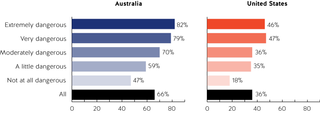More than 230,000 new COVID-19 cases were confirmed in the United States on Wednesday 13 January. Cumulatively, nearly 23.5 million Americans have been confirmed as carrying COVID-19 and nearly 400,000 have died with the virus.
The Trump administration’s Operation Warp Speed saw billions of dollars committed to public-private partnerships to speed up the development and distribution of COVID-19 vaccines. This program was successful in delivering an effective vaccine in December 2020, less than a year after the coronavirus was first identified.
The United States Studies Centre at the University of Sydney surveyed 1,500 Americans and 1,619 Australians in early October 2020 to better understand the attitudes of Americans and Australians towards a COVID-19 vaccine.
The results of the surveys indicate that the development of a vaccine is unlikely to end the threat posed by COVID-19 in the United States.
Most Australians say they will take a vaccine for the coronavirus, but only a quarter of Americans say they are extremely or very likely to do so. Even a significant number of healthcare workers are refusing the take the vaccine.
Most Australians say they will use vaccine, Americans less likely
A majority, 66 per cent of Australians report they would be extremely or very likely to use a vaccine if it was approved for human use and made freely available for all (Figure 1). Just eight per cent say they are not at all likely to do so. Conversely, just 36 per cent of Americans say they extremely or very likely to use such a vaccine, while 26 per cent report they were not all likely to.
Figure 1. Proportion of Australians and Americans who say they are very likely/extremely likely to use a COVID-19 vaccine if it was approved for human use and made freely available

Willingness to use vaccine lowest with Trump voters, but American willingness generally lower than Australian
In Australia, willingness to use a vaccine is bipartisan, with very similar numbers of Coalition, Labor and Greens voters saying they are extremely or very likely to use a vaccine when it is available (also shown in Figure 1). However, respondents who voted for other parties or did not vote are less likely to use the vaccine, with 19 per cent saying it was not likely at all that they would take the vaccine.
In the United States, respondents who said they were voting for President Trump in the 2020 election say they are less likely to use a vaccine than supporters of President-elect Biden. Only 34 per cent of Trump voters said they were extremely or very likely to use a vaccine if available, and 33 per cent said it was not likely at all.
However, this relative lack of enthusiasm for a COVID vaccine is not a purely partisan affair. Biden voters were also less likely to say they were extremely or very likely to use a vaccine for COVID-19 (46 per cent) than the supporters of any major Australian party.
Opposition to vaccines strongest among those who do not see COVID-19 as a risk
One possible driver for lower rates of willingness to use a vaccine is different rates of perceived risk from the coronavirus in the two countries. To test this, we asked respondents to assess the danger they felt personally from the virus.
Figure 2 shows that Australians and Americans make similar assessments of the personal dangers of COVID-19. In Australia, 10 and 16 per cent of respondents see the virus as extremely or very dangerous, while 13 per cent see it as not at all dangerous. Similarly, 14 per cent of Americans see the virus as extremely dangerous and another 14 per cent view it as very dangerous. Seventeen per cent of Americans say the virus is not at all dangerous, four percentage points more than in Australia.
Australians are thus more likely than Americans to accept the COVID-19 vaccine irrespective of the personally assessed level of danger from COVID-19 (see Figure 3). In the Australian sample, 65 per cent of respondents who rate COVID-19 as extremely dangerous said they were also extremely likely to take the vaccine; in the United States the corresponding figure is just 34 per cent. Even among those who thought the virus was not at all dangerous, 26 per cent in Australia reported they were extremely likely to use the vaccine, versus 10 per cent in the United States. Conversely, among this group reporting that the coronavirus is not personally dangerous, 24 per cent in Australia thought they were not at all likely to use the vaccine, compared with 56 per cent of Americans.
Figure 2. How dangerous do Australians and Americans perceive COVID-19 to be? (Proportion of respondents)

Figure 3. Proportion of Australians and Americans who say they are very likely/extremely likely to use a vaccine if it was approved for human use and made freely available, by the perceived danger posed by COVID-19

About the survey data
These surveys were fielded between 13-19 October 2020, by YouGov, a global public opinion and data company, to samples drawn from YouGov panels of respondents who have previously agreed to take surveys online. The samples consisted of 1,500 American respondents and 1,619 Australians.
The Australian sample was formed by first segmenting the YouGov Australian panel on gender, age and region (urban/rural distinction within each state), matching the distributions of those variables in the adult, citizen Australian population provided by the 2016 Census. Randomly selected panellists in each segment were invited to take the survey. After data collection, the responses were weighted to match the distributions of age, gender and region (as provided by the 2016 Census, again subset to adult citizens). These two steps ensure the sample is representative of the adult, citizen population of Australia.
The US sample was formed by first segmenting the YouGov US panel on gender, age, race, and education, matching the distributions of those variables in the adult, citizen population of the US provided by 2016 American Community Survey 1-year sample. Randomly selected panellists in each segment were invited to take the survey. After data collection the responses were weighted to match the distributions of age, gender, race, education and vote choice at the 2016 presidential election (based on official vote tabulations).
The maximum margin of error for each data set is approximately ±3 percentage points. It is larger for differences in results between the two countries, and for population subgroups within the samples.
Questions asked
If a vaccine for coronavirus (COVID-19) is approved for human use and made freely available for all, how likely are you to take it?
Single select; random reverse scale 1-5
- Extremely likely
- Very likely
- Somewhat likely
- Slightly likely
- Not at all likely
How dangerous is the coronavirus (COVID-19) pandemic for: Yourself
Columns; random reverse scale 1-5
- Extremely dangerous
- Very dangerous
- Moderately dangerous
- A little dangerous
- Not at all dangerous







